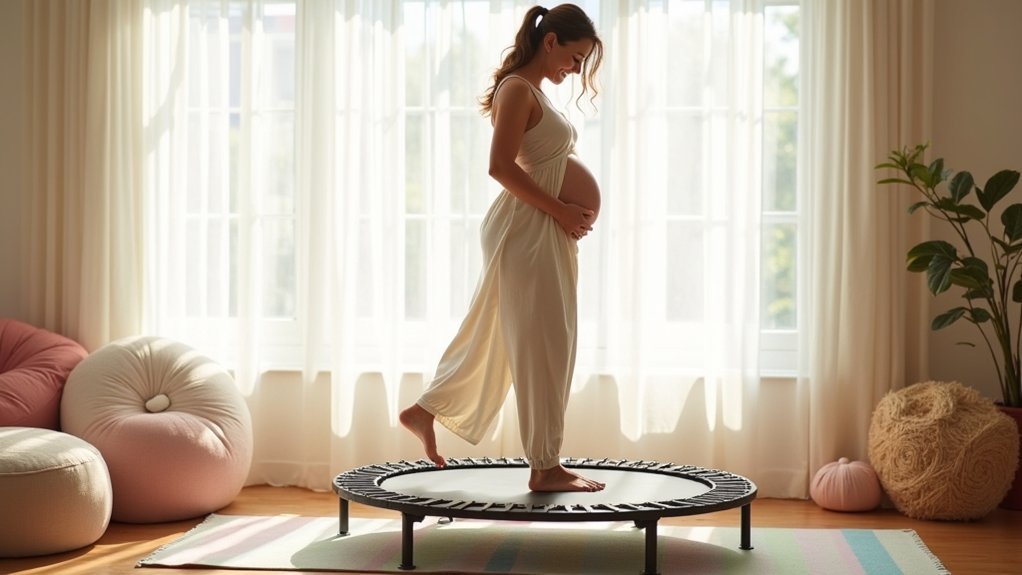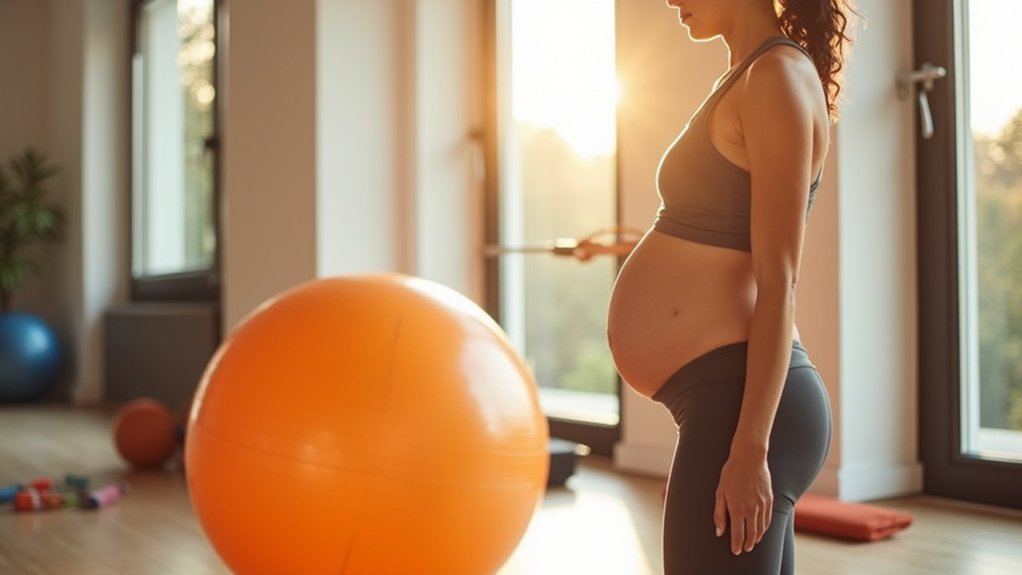During pregnancy, you can safely enjoy seven levels of rebounding: low amplitude first trimester bounces, modified balance-focused movements, gentle alternatives like stability ball workouts, supported bouncing using chairs or walls, therapeutic lymphatic-stimulating sessions, progressive resistance rebounds, and recovery cool-down bounces. Always get medical clearance first, maintain controlled movements, and monitor how you feel throughout. The right technique transforms this low-impact exercise into a safe, effective way to stay active while protecting your changing body.
First Trimester: Low Amplitude Rebounding Techniques

While the first trimester brings significant physical changes, low-amplitude rebounding can provide a gentle yet effective workout option for expectant mothers. Before starting, consult your healthcare provider to confirm it’s safe for your specific pregnancy.
Focus on controlled movements like gentle marches, heel lifts, and side-to-side weight shifts without leaving the rebounder surface. Keep sessions between 15-30 minutes to prevent overexertion, and take frequent water breaks. Always listen to your body and make necessary adjustments since the first trimester often requires a graceful approach to fitness.
Your body benefits from improved circulation to reduce swelling, increased energy to combat first-trimester fatigue, and core engagement that strengthens your pelvic floor.
Stop immediately if you experience dizziness, vaginal bleeding, or shortness of breath.
Use a stable rebounder with locked legs and wear supportive shoes to maximize safety as your center of gravity begins to shift.
Modified Rebounding for Changing Balance
As your pregnancy progresses, your body’s center of gravity shifts dramatically, requiring thoughtful adjustments to your rebounding routine. Widen your stance while bouncing to lower your center of gravity and enhance stability. Slow your tempo to under 100 beats per minute for controlled movements and fall prevention.
After week 20, avoid backward or diagonal bouncing due to reduced spatial awareness. Instead, incorporate side-to-step shuffles rather than hops as your weight redistributes anteriorly. Always remember that high-impact exercises should be avoided during pregnancy to ensure safety for both you and your baby.
For third-trimester sessions, maintain partial foot contact with the rebounder surface. Use available supports—handlebars or wall rails—during lateral movements.
Create a 3-foot hazard-free zone around your equipment and exercise in 68-72°F environments to prevent dizziness. Consider altering to seated pelvic lifts on stable surfaces if standing becomes uncomfortable.
Gentle Bounce Alternatives for Joint Protection

When your pregnancy limits traditional bouncing, try low-impact pool exercises that protect your joints while providing buoyancy and resistance.
You’ll find prenatal stability balls offer gentle options for movement that support your changing center of gravity and strengthen your core. Incorporating pelvic tilting exercises can help alleviate lower back discomfort while maintaining proper posture during ball exercises.
Seated bounce movements on a birthing ball can give you the benefits of gentle movement without stressing your relaxin-softened joints.
Low-Impact Pool Exercises
For expectant mothers seeking gentle alternatives to bouncing workouts, water-based exercises offer exceptional benefits without compromising joint health. The buoyancy of water reduces stress on your joints, providing relief for aching muscles and preventing excessive strain on your changing body.
Try water walking, swimming, or pool aerobics to maintain cardiovascular fitness while protecting your joints. These activities not only help manage weight gain but can also reduce back pain and swelling in your legs and feet. Water supports the belly, relieving pressure on your spine throughout your pregnancy.
Many pregnant women report improved posture, better circulation, and enhanced body image with regular aquatic exercise.
Before diving in, consult your healthcare provider, verify the pool temperature is comfortable, and avoid high-impact movements. With professional guidance, you’ll find water exercises both invigorating and therapeutic during this special time.
Prenatal Ball Stability
Stability balls offer pregnant women a versatile alternative to high-impact bouncing exercises while still maintaining fitness and balance.
You’ll find gentle options like pelvic tilts and circles that strengthen your core without stressing your joints.
Try seated ball marching or wall squats with ball support to build strength through proper alignment. These exercises enhance your balance and proprioception—crucial skills as your center of gravity shifts during pregnancy.
For upper body conditioning, wall push-ups and planks on the ball can be modified to your comfort level.
When performing any stability ball exercise, focus on progressive resistance and maintaining proper alignment. Easing back pain during pregnancy is another significant benefit of regular birthing ball use.
Incorporate breathing techniques to enhance relaxation while exercising. A soft floor surface provides additional joint protection, making your prenatal workouts both effective and gentle on your changing body.
Seated Bounce Movements
Seated bounce movements offer five major joint-protective advantages for expectant mothers seeking low-impact exercise alternatives. The 2-3 inch vertical oscillations reduce axial loading on your spine while distributing weight evenly across your pelvic floor and ischial tuberosities.
For ideal joint protection, maintain a wide-legged position (knees at 100-120°) with proper ball inflation allowing 90-100° knee flexion when seated. Keep your bouncing rhythm between 60-80 bpm to mimic natural walking cadence while engaging your glutes to protect your lumbar spine. Regular practice can lead to an uncomplicated natural birth with reduced need for interventions.
Limit sessions to under 5 minutes with regular posture checks. This movement pattern not only protects joints but also promotes labor preparation through improved fetal positioning and increased pelvic circulation.
Always use non-slip mats and discontinue if you experience pelvic pain.
Stability-Focused Bouncing With Support

You’ll find greater stability during pregnancy workouts by using a chair for modified bouncing exercises that keep one hand on the chair back at all times.
Wall-braced gentle rebounds offer another safe option, allowing you to maintain balance while still enjoying some of the cardiovascular benefits of bouncing movements.
For ideal safety, try partner-assisted stability exercises where your workout buddy provides physical support during controlled, low-impact bouncing routines. Remember that pregnancy causes your center of gravity to shift as your belly grows, making these supported bouncing options even more important for preventing falls.
Chair-Supported Bounce Techniques
When properly executed, chair-supported bounce techniques offer pregnant women a safe way to maintain physical activity without compromising stability.
Select a high-backed chair with armrests and an adjustable height to accommodate your changing body. Place it on a non-slip surface with ample space around you.
Maintain proper alignment with your back straight against the chair and perform only gentle, controlled bounces. Distribute your weight evenly and avoid excessive movement that could strain your body. Remember to manage how far you lean forward to protect your back. Using lumbar support pillows can provide additional comfort and proper spine alignment during seated bounce exercises.
Always get your healthcare provider’s clearance before starting, and consider your pregnancy stage when adjusting intensity.
You’ll need to be more cautious in your third trimester, keeping bounces minimal and controlled. Have someone nearby for assistance when possible.
Wall-Braced Gentle Rebounds
Wall-braced gentle rebounds offer another supportive option for maintaining physical activity during pregnancy. By using a wall for balance, you’ll enhance stability while performing low-impact movements that minimize risk to your changing body.
These exercises strengthen your core muscles while improving balance, which becomes increasingly important as your center of gravity shifts. You’ll also experience stress reduction and improved flexibility without straining your hormone-loosened joints and ligaments. This type of movement can help manage depression symptoms during pregnancy while providing a gentle form of exercise.
When practicing wall-braced rebounds, maintain proper posture and use appropriate breathing techniques to stabilize your core. Remember to avoid overheating and overexertion by gradually increasing intensity as your comfort allows.
For maximum benefit, combine these movements with other pregnancy-safe activities like prenatal yoga, walking, or birth ball exercises—always with your healthcare provider’s approval.
Partner-Assisted Stability Exercises
Partner-assisted stability exercises provide three essential benefits for expectant mothers: enhanced safety, improved balance, and greater confidence during bouncing workouts. Always verify your healthcare provider approves these activities before beginning.
| Exercise Type | Partner’s Role |
|---|---|
| Mini-Trampoline | Stand alongside, holding both hands for stability |
| Core Engagement | Support your lower back during gentle bounces |
| Pelvic Floor Work | Monitor your movements and provide feedback |
| Weight Transfer | Stabilize your shoulders during side-to-side motion |
| Twisting Movements | Guide your rotation to prevent overextension |
Before starting, warm up with gentle stretches and create a safe environment with non-slip flooring and adequate space. Your partner should maintain consistent communication with you, immediately stopping if you experience discomfort. Remember to engage your core throughout each movement to maximize stability. When performing gentle twisting exercises, your partner should assist by anchoring your shoulder to the floor to prevent excessive rotation and maintain proper alignment.
Therapeutic Rebounding for Circulation and Lymphatic Flow
Although often overlooked, therapeutic rebounding offers pregnant women significant benefits for circulation and lymphatic flow. When you gently bounce on a mini trampoline, you’ll stimulate your lymphatic system, potentially reducing pregnancy-related swelling and improving overall blood circulation.
Focus on controlled, low-impact movements that maintain your balance while engaging your core muscles. According to research, rebounding presents potential risks during pregnancy and should be approached with caution. Incorporate deep breathing techniques during your rebounding sessions to enhance relaxation and maximize circulatory benefits.
Practice gentle, balanced movements with mindful breathing to enhance both circulation and relaxation during pregnancy rebounding.
Remember to monitor your heart rate and body temperature throughout your workout. For ideal safety, use a quality mini trampoline with stability bars, especially as your pregnancy progresses and your center of gravity shifts.
Always listen to your body and stop immediately if you experience any discomfort. Consult your healthcare provider before beginning any rebounding routine.
Progressive Resistance Levels on Mini Trampolines
Many pregnant women can safely incorporate progressive resistance into their mini trampoline workouts by following a structured approach.
Start with gentle, controlled bounces that keep your feet close to the surface, gradually increasing intensity as your comfort and balance allow.
Focus on low-impact movements that protect your pelvic floor, using stabilizing handrails for added safety as your center of gravity shifts. Remember that pregnancy is uniquely individual, and what works for one person may not be appropriate for another due to varying circumstances.
Engage your core muscles throughout each exercise to support your back and maintain proper form.
Monitor your heart rate during workouts and stop immediately if you experience any discomfort.
Incorporate side-to-side movements to engage different muscle groups while maintaining stability.
Always consult your healthcare provider before beginning or adjusting your trampoline routine to address your individual pregnancy circumstances.
Recovery Bouncing: Post-Workout Cool Down Methods
Proper cool-down techniques after trampoline workouts are essential during pregnancy to guarantee both maternal and fetal safety. Dedicate 5-10 minutes to gradually reduce your bouncing intensity before stopping completely, which prevents blood pooling and dizziness.
Never skip your post-trampoline cool-down during pregnancy—it’s vital for protecting both you and your baby.
Follow with gentle static stretches targeting your hamstrings, quadriceps, and hip flexors while incorporating deep breathing to enhance relaxation. This recovery period should be prioritized to help lower your heart rate safely after exercise.
- Maintain hydration by consuming 8 oz of water for every 15 minutes of exercise, sipping gradually rather than gulping large amounts at once.
- Focus on postural alignment with pelvic tilts and shoulder blade squeezes to counteract pregnancy-related posture changes.
- Modify stretches as your pregnancy progresses, avoiding deep twists and supine positions beyond your first trimester.
Frequently Asked Questions
Can Rebounding Help With Pregnancy-Related Constipation or Digestive Issues?
Rebounding may help with constipation by stimulating gut motility, similar to abdominal massage. You’ll want to keep it low-impact and consult your healthcare provider first, as pelvic floor safety remains important.
Should I Wear a Pregnancy Support Belt During Bouncing Workouts?
Yes, you should wear a pregnancy support belt during bouncing workouts. It’ll stabilize your pelvis, reduce discomfort, improve posture, and minimize joint strain while you exercise. Just make certain it’s properly fitted for maximum benefit.
How Does Rebounding Affect Pelvic Floor Strength During Pregnancy?
Rebounding can strain your pelvic floor during pregnancy. You’ll need to balance low-impact bouncing with pelvic floor exercises. If you’ve got existing weakness, you should prioritize strengthening before adding this high-impact activity.
At What Point Should I Completely Stop Trampoline Workouts?
You should completely stop trampoline workouts as soon as you confirm your pregnancy. The risk of falls, joint instability, and potential harm to you and your baby outweighs any fitness benefits.
Can Rebounding Exercises Help Manage Pregnancy-Related Edema or Swelling?
Yes, rebounding can help manage your pregnancy-related edema by stimulating lymphatic flow. When you bounce gently, you’re increasing circulation and encouraging fluid movement, which may reduce swelling in your extremities. Always consult your doctor first.
In Summary
You’ve discovered that rebounding can be safely enjoyed throughout your pregnancy when properly modified. By progressing through these seven levels, you’ll maintain fitness while protecting your changing body. Remember to listen to your body’s signals, stay hydrated, and consult your healthcare provider before beginning. With the right approaches, you’ll benefit from improved circulation, reduced swelling, and maintained strength as you prepare for delivery.





Leave a Reply